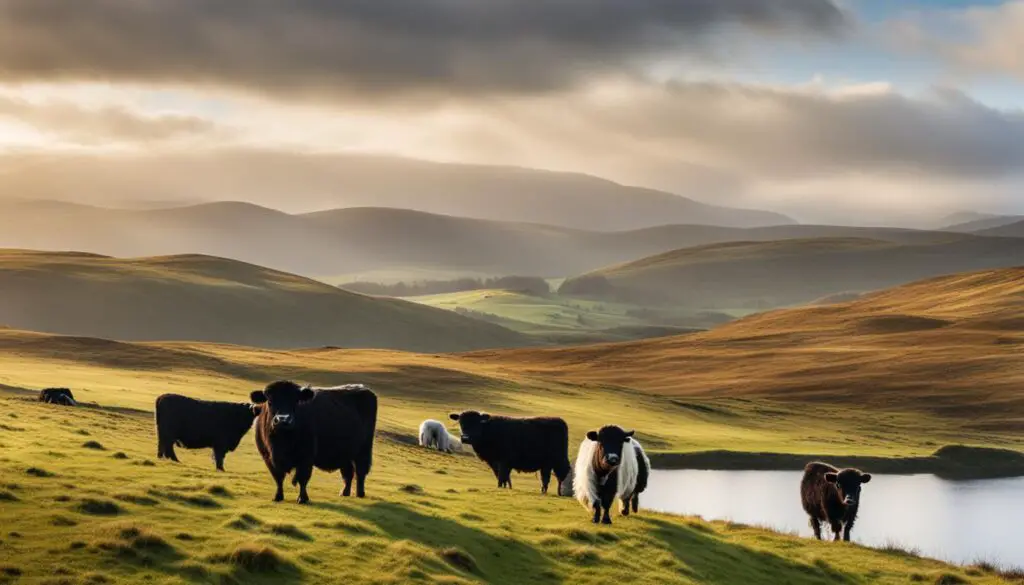With their distinctive black-and-white belts and shaggy coats, belted galloway cows are a beloved breed that has captured the hearts of cattle farmers and enthusiasts around the world. But where did belted galloway cows originate from? What is the history behind this remarkable breed?
In this section, we will delve into the fascinating history and heritage of belted galloway cattle. From their early origins to their growing popularity and spread, we will explore the historical context and factors that contributed to the development and success of this unique breed.
Key Takeaways:
- Belted Galloway cows are a distinctive and beloved breed with a rich history.
- Their origin can be traced back to Scotland, where their unique appearance and hardiness made them a popular breed.
- Their popularity has grown steadily over the years, making them a successful and resilient breed in agriculture today.
Early Origins of the Belted Galloway Cows
The belted galloway cattle breed has a rich history that dates back centuries. The origins of this beloved breed can be traced back to the rugged and harsh environments of the Scottish countryside.
The exact origin of belted galloway cows is not very clear, but it is believed that they descended from ancient Galloway cattle. These cattle were hardy and could easily survive long, cold Scottish winters, making them a prized possession for many local farmers.
The distinct white belt that these cows are known for is believed to have developed due to a genetic mutation. This trait eventually became dominant, and the belted galloway breed was born. These cows were initially valued for their beef, milk, and skin, which were important commodities during the early days of Scottish agriculture.
The early development of the belted galloway cattle breed is also said to have been heavily influenced by the Viking invasions of Scotland during the Middle Ages. The Vikings are said to have brought their own cattle breeds to Scotland, which eventually interbred with the native cattle and contributed to the development of the belted galloway breed.
Despite the tough living conditions and harsh environment, the belted galloway cows proved to be incredibly resilient and adaptable. They continued to thrive and evolve over the years, eventually making their way to other parts of the world, including North America.
Scottish Heritage and Influence
The belted galloway cattle breed has deep roots in Scotland, where they were originally bred in the rugged and hilly terrain of Galloway, a region in the southwestern part of the country. The cattle were uniquely adapted to the harsh climate and landscape of Galloway, developing certain physical characteristics that set them apart from other cattle breeds.
Given their Scottish origin, it’s unsurprising that belted galloway cows have played a significant role in the country’s agricultural practices and traditions. In fact, the breed’s resilience and adaptability made them essential to the economy and food supply of Scotland for many years.
The belted galloway’s distinctive appearance, with its white belt and black coat, is also of great cultural significance. The belt and coat are said to resemble the Scottish tartan, and the cattle have become a symbol of Scottish heritage and identity.

“The belted galloway cattle are a source of pride for the people of Scotland. Their unique look and hardiness have made them important to our heritage and livelihood.”
Arrival in North America
As the popularity of belted galloway cows continued to grow in Scotland, it wasn’t long before they caught the attention of American breeders. In the early 20th century, several belted galloway cows were imported from Scotland to North America.
The introduction of belted galloway cows to North America initially faced some resistance as the breed was relatively unknown. However, they quickly gained a reputation for their hardiness and adaptability, proving to be well suited to the harsh North American climate.
Today, belted galloway cows can be found throughout North America, from small hobby farms to large commercial operations. Their unique characteristics and distinctive appearance make them a beloved breed among farmers and cattle enthusiasts alike.
Popularity and Spread
The belted galloway cows have gained significant popularity in recent years, gaining a strong following among farmers and meat enthusiasts alike. Their unique appearance, hardy nature, and quality meat have contributed to their increasing popularity.
The breed has expanded its reach beyond its Scottish roots, with belted galloway cows now found all over North America. According to the American Belted Galloway Association, the breed is present in almost every state in the US and continues to grow in numbers.

The belted galloway’s popularity has also extended beyond North America, with an increasing number of breeders and farms in Europe, Australia, and New Zealand. The demand for the breed’s unique qualities has contributed to their continued distribution and success.
Modern-Day Belted Galloway Cows
The belted galloway cows have evolved and adapted to modern times while still maintaining their unique characteristics that have made them a beloved breed in the world of agriculture. The contemporary belted galloway breed is still known for their distinctive appearance, with their beautiful belted coats and compact stature that make them well-suited for smaller farms and grazing pastures.
Modern belted galloway cattle have undergone genetic improvements in recent years to enhance their production qualities, including better growth rates and improved meat quality. Present-day belted galloway cows are known for having a docile temperament, making them an excellent choice as a family-friendly breed.
The significance of belted galloway cows in agriculture continues to this day, with their popularity spreading around the world. Their hardiness, easy-to-keep nature, and unique appearance make them an ideal breed for smaller-scale farming operations. In addition, their high-quality meat is in demand by consumers who appreciate the breed’s heritage and the care that goes into raising them.
Conclusion
In conclusion, the belted galloway cows have a fascinating history and have become a globally recognized breed. They originated from Scotland and have since spread across the world, captivating farmers with their unique characteristics and adaptability. Today, they continue to remain relevant in agriculture due to their hardiness and versatility.
FAQ
Where did belted galloway cows originate from?
Belted galloway cows originated from Scotland.
What is the history of belted galloway cows?
The history of belted galloway cows dates back centuries, with their roots firmly planted in Scotland. They were bred for their hardiness and ability to withstand harsh weather conditions.
What is the origin of the belted galloway breed?
The belted galloway breed originated in the Galloway region of southwestern Scotland. Farmers in this area developed the breed for its distinct appearance and resilience.
How did belted galloway cows arrive in North America?
Belted galloway cows were introduced to North America in the early 20th century. They were primarily brought over from Scotland and other parts of the United Kingdom.
Why did belted galloway cows become popular?
Belted galloway cows gained popularity for their unique appearance, hardiness, and versatility. They quickly became favored among farmers and ranchers for their ability to thrive in various climates and landscapes.
What is the current status of belted galloway cows?
Today, belted galloway cows are a recognized and cherished breed in the world of agriculture. They continue to be bred and raised for their distinctive belt pattern, excellent foraging abilities, and adaptability.

